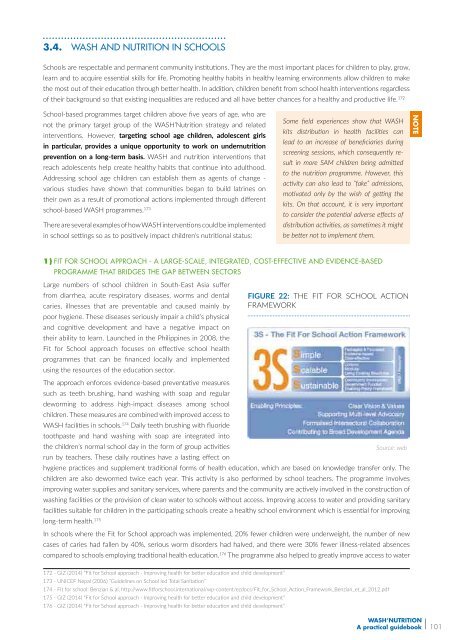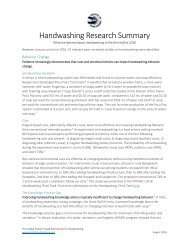WASH’ Nutrition
manuel_wash_nutrition_online
manuel_wash_nutrition_online
Create successful ePaper yourself
Turn your PDF publications into a flip-book with our unique Google optimized e-Paper software.
3.4. WASH and nutrition in schools<br />
Schools are respectable and permanent community institutions. They are the most important places for children to play, grow,<br />
learn and to acquire essential skills for life. Promoting healthy habits in healthy learning environments allow children to make<br />
the most out of their education through better health. In addition, children benefit from school health interventions regardless<br />
of their background so that existing inequalities are reduced and all have better chances for a healthy and productive life. 172<br />
School-based programmes target children above five years of age, who are<br />
not the primary target group of the <strong>WASH’</strong><strong>Nutrition</strong> strategy and related<br />
interventions. However, targeting school age children, adolescent girls<br />
in particular, provides a unique opportunity to work on undernutrition<br />
prevention on a long-term basis. WASH and nutrition interventions that<br />
reach adolescents help create healthy habits that continue into adulthood.<br />
Addressing school age children can establish them as agents of change -<br />
various studies have shown that communities began to build latrines on<br />
their own as a result of promotional actions implemented through different<br />
school-based WASH programmes. 173<br />
There are several examples of how WASH interventions could be implemented<br />
in school settings so as to positively impact children’s nutritional status:<br />
Some field experiences show that WASH<br />
kits distribution in health facilities can<br />
lead to an increase of beneficiaries during<br />
screening sessions, which consequently result<br />
in more SAM children being admitted<br />
to the nutrition programme. However, this<br />
activity can also lead to “fake” admissions,<br />
motivated only by the wish of getting the<br />
kits. On that account, it is very important<br />
to consider the potential adverse effects of<br />
distribution activities, as sometimes it might<br />
be better not to implement them.<br />
NOTE<br />
1) Fit for school approach - a large-scale, integrated, cost-effective and evidence-based<br />
programme that bridges the gap between sectors<br />
Large numbers of school children in South-East Asia suffer<br />
from diarrhea, acute respiratory diseases, worms and dental<br />
caries, illnesses that are preventable and caused mainly by<br />
poor hygiene. These diseases seriously impair a child’s physical<br />
and cognitive development and have a negative impact on<br />
their ability to learn. Launched in the Philippines in 2008, the<br />
Fit for School approach focuses on effective school health<br />
programmes that can be financed locally and implemented<br />
using the resources of the education sector.<br />
FIGURE 22: The Fit for School Action<br />
Framework<br />
The approach enforces evidence-based preventative measures<br />
such as teeth brushing, hand washing with soap and regular<br />
deworming to address high-impact diseases among school<br />
children. These measures are combined with improved access to<br />
WASH facilities in schools. 174 Daily teeth brushing with fluoride<br />
toothpaste and hand washing with soap are integrated into<br />
the children’s normal school day in the form of group activities<br />
Source: web<br />
run by teachers. These daily routines have a lasting effect on<br />
hygiene practices and supplement traditional forms of health education, which are based on knowledge transfer only. The<br />
children are also dewormed twice each year. This activity is also performed by school teachers. The programme involves<br />
improving water supplies and sanitary services, where parents and the community are actively involved in the construction of<br />
washing facilities or the provision of clean water to schools without access. Improving access to water and providing sanitary<br />
facilities suitable for children in the participating schools create a healthy school environment which is essential for improving<br />
long-term health. 175<br />
In schools where the Fit for School approach was implemented, 20% fewer children were underweight, the number of new<br />
cases of caries had fallen by 40%, serious worm disorders had halved, and there were 30% fewer illness-related absences<br />
compared to schools employing traditional health education. 176 The programme also helped to greatly improve access to water<br />
172 - GIZ (2014) “Fit for School approach - Improving health for better education and child development”<br />
173 - UNICEF Nepal (2006) “Guidelines on School led Total Sanitation”<br />
174 - Fit for school: Benzian & al, http://www.fitforschool.international/wp-content/ezdocs/Fit_for_School_Action_Framework_Benzian_et_al_2012.pdf<br />
175 - GIZ (2014) “Fit for School approach - Improving health for better education and child development”<br />
176 - GIZ (2014) “Fit for School approach - Improving health for better education and child development”<br />
<strong>WASH’</strong><strong>Nutrition</strong><br />
A practical guidebook<br />
101



